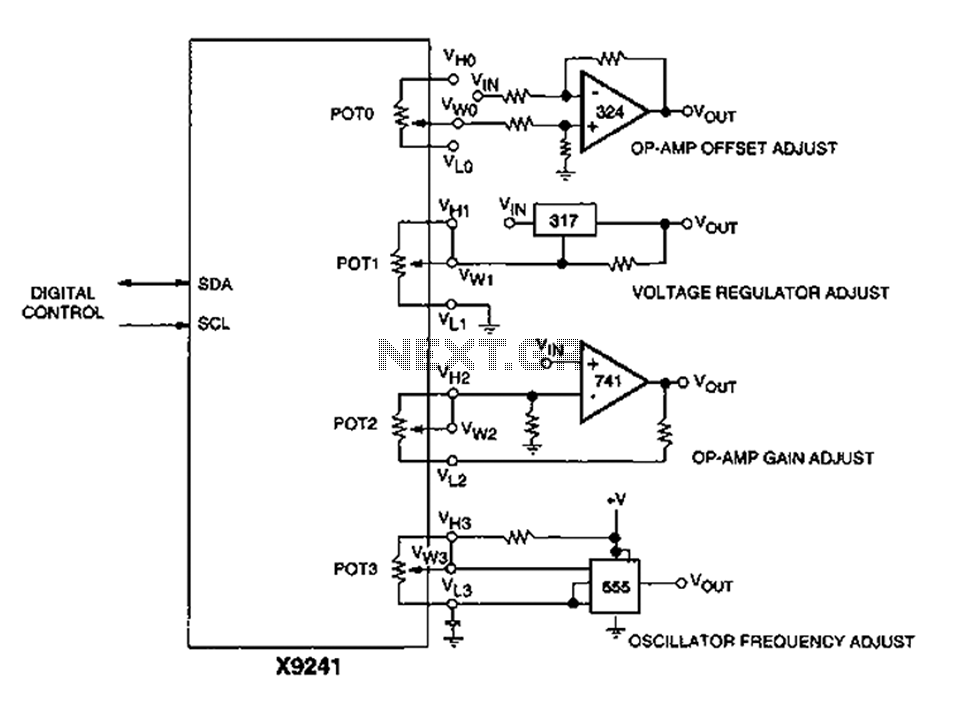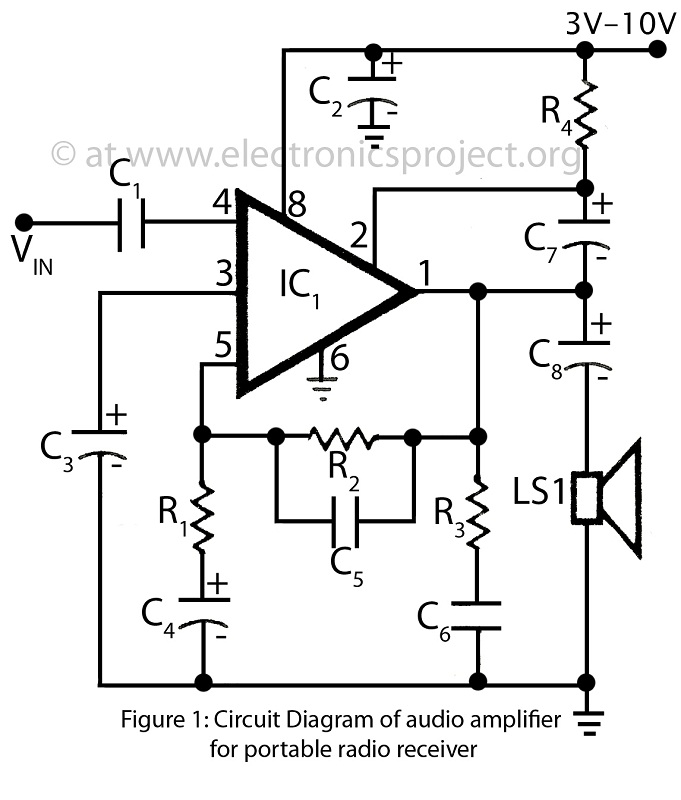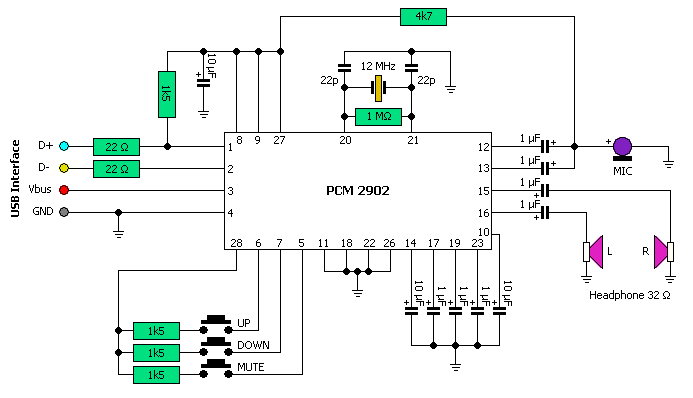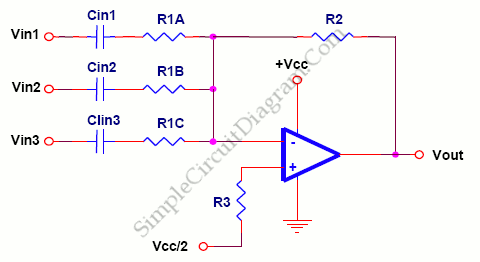
portable mixer block diagram
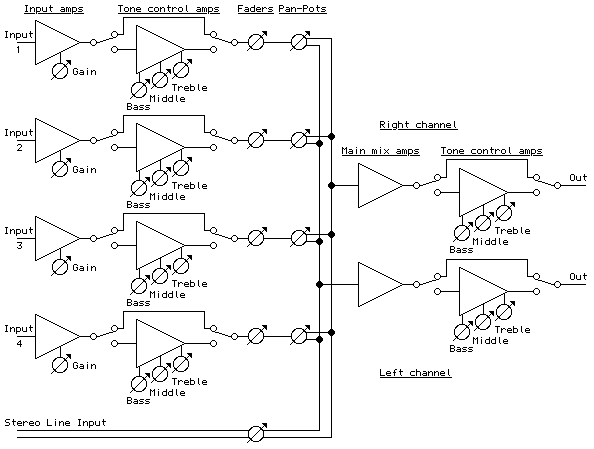
The image below depicts a block diagram of a complete mixer that consists of four input amplifier modules followed by four switchable tone management modules, one stereo line input, four mono main faders, one stereo dual-ganged main fader, four pan pots, a stereo main mixer amplifier module, and two additional switchable tone management modules for each channel, inserted before the main left and right outputs. This layout can be rearranged according to individual preferences. Notably, this design features an impressive current draw of only 6mA for the entire stereo mixer, as illustrated in the block diagram. The fundamental configuration of this circuit is derived from a recent quad magnetic pick-up cartridge module, which has been modified to accommodate microphone inputs and operate on a single-rail low voltage supply. This low-noise, fully symmetrical, two-transistor head amplifier design permits the use of a conventional FET input operational amplifier as the second gain stage, even for highly sensitive microphone inputs.
The described mixer circuit is structured to optimize audio signal processing with a focus on low power consumption and high fidelity. The four input amplifier modules serve to boost the signals from various audio sources, ensuring that they are at an appropriate level for further processing. Each of these modules is designed to handle specific input types, including dynamic and condenser microphones, as well as line-level signals, providing versatility in audio mixing applications.
The four switchable tone management modules allow for the adjustment of tonal characteristics for each input channel, enabling the user to tailor the sound to their specific requirements. These modules can apply equalization, filtering, and other effects, enhancing the overall audio quality. The inclusion of a stereo line input further broadens the mixer's capabilities, allowing for the integration of external audio devices.
The main faders, including both mono and dual-ganged stereo configurations, provide precise control over the audio levels of each channel. The pan pots facilitate the spatial placement of audio signals within the stereo field, giving the mixer additional creative control. The stereo main mixer amplifier module combines all processed signals and amplifies them for output, ensuring a robust final mix.
The additional tone management modules before the main outputs are crucial for final adjustments, allowing for a last-minute enhancement of the audio signal before it is sent to the output stage. This modular approach not only enhances flexibility but also allows for easy upgrades or modifications to the mixer setup.
The circuit's low-noise and symmetrical design are particularly beneficial for professional audio applications, where signal integrity is paramount. The use of a two-transistor head amplifier layout minimizes distortion and noise, while the integration of a FET input operational amplifier as the second gain stage ensures compatibility with sensitive microphone inputs. This thoughtful configuration results in a mixer that is not only efficient in power usage but also capable of delivering high-quality audio performance across a wide range of applications.The image below shows a Block diagram of the entire mixer that includes four Input Amplifier Modules followed by four in-out switchable Tone management Modules, one stereo Line input, four mono Main Faders, one stereo dual-ganged Main Fader, four Pan-Pots, a stereo Main Mixer Amplifier Module and two additional Tone management Modules switchable i n and out for every channel, inserted before the main Left and Right outputs. Obviously this layout is rearranged at everyone want. An astonishing feature of this design lies within the fact that a whole stereo mixer as shown below within the Block diagram attracts but 6mA current! The basic arrangement of this circuit comes from the recent Quad magnetic pick-up cartridge module. The circuit was rearranged to address microphone input and a single-rail low voltage provide. This low-noise, absolutely symmetrical, two-transistor head amplifier layout, allows the utilization of a traditional FET input Op-Amp as the second gain stage, even for terribly sensitive microphone inputs.
🔗 External reference
The described mixer circuit is structured to optimize audio signal processing with a focus on low power consumption and high fidelity. The four input amplifier modules serve to boost the signals from various audio sources, ensuring that they are at an appropriate level for further processing. Each of these modules is designed to handle specific input types, including dynamic and condenser microphones, as well as line-level signals, providing versatility in audio mixing applications.
The four switchable tone management modules allow for the adjustment of tonal characteristics for each input channel, enabling the user to tailor the sound to their specific requirements. These modules can apply equalization, filtering, and other effects, enhancing the overall audio quality. The inclusion of a stereo line input further broadens the mixer's capabilities, allowing for the integration of external audio devices.
The main faders, including both mono and dual-ganged stereo configurations, provide precise control over the audio levels of each channel. The pan pots facilitate the spatial placement of audio signals within the stereo field, giving the mixer additional creative control. The stereo main mixer amplifier module combines all processed signals and amplifies them for output, ensuring a robust final mix.
The additional tone management modules before the main outputs are crucial for final adjustments, allowing for a last-minute enhancement of the audio signal before it is sent to the output stage. This modular approach not only enhances flexibility but also allows for easy upgrades or modifications to the mixer setup.
The circuit's low-noise and symmetrical design are particularly beneficial for professional audio applications, where signal integrity is paramount. The use of a two-transistor head amplifier layout minimizes distortion and noise, while the integration of a FET input operational amplifier as the second gain stage ensures compatibility with sensitive microphone inputs. This thoughtful configuration results in a mixer that is not only efficient in power usage but also capable of delivering high-quality audio performance across a wide range of applications.The image below shows a Block diagram of the entire mixer that includes four Input Amplifier Modules followed by four in-out switchable Tone management Modules, one stereo Line input, four mono Main Faders, one stereo dual-ganged Main Fader, four Pan-Pots, a stereo Main Mixer Amplifier Module and two additional Tone management Modules switchable i n and out for every channel, inserted before the main Left and Right outputs. Obviously this layout is rearranged at everyone want. An astonishing feature of this design lies within the fact that a whole stereo mixer as shown below within the Block diagram attracts but 6mA current! The basic arrangement of this circuit comes from the recent Quad magnetic pick-up cartridge module. The circuit was rearranged to address microphone input and a single-rail low voltage provide. This low-noise, absolutely symmetrical, two-transistor head amplifier layout, allows the utilization of a traditional FET input Op-Amp as the second gain stage, even for terribly sensitive microphone inputs.
🔗 External reference
